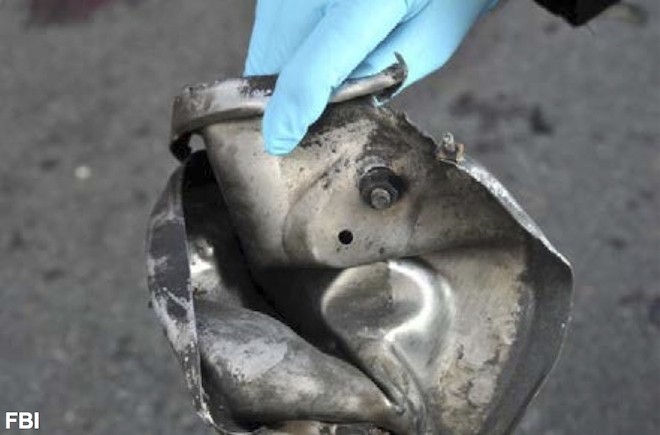Boston, Day 3: Officials say reports of an arrest are false
Third victim was Chinese graduate student Lu Lingzi, say reports
This image from a Federal Bureau of Investigation and Department of Homeland Security joint bulletin issued to law enforcement and obtained by The Associated Press, shows the remains of a pressure cooker that the FBI says was part of one of the bombs that exploded during the Boston Marathon. The FBI says it has evidence that indicates one of the bombs was contained in a pressure cooker with nails and ball bearings, and it was hidden in a backpack. (AP Photo/FBI)
Share
Officials say no arrest has been made in connection with the Boston Marathon bombings, contradicting numerous media reports earlier today.
“Contrary to widespread reporting, no arrest has been made in connection with the Boston Marathon attack,” the FBI said in a statement. Similarly worded comments came via Boston police: “Despite reports to the contrary there has not been an arrest in the Marathon attack,” the department tweeted at around 2:30 p.m.
Earlier in the day, conflicting stories emerged on whether an arrest was imminent — or had already taken place — in connection with the bombings, or whether those rapidly circulating reports were false. Numerous outlets, including the Boston Globe and the Associated Press, earlier suggested a possible or imminent arrest. CNN, one of the first outlets to claim an arrest had taken place, has since updated its website, which now reports “confusion over arrest reports” in the Boston bombing.
An FBI briefing on the investigation previously scheduled for 5 p.m. ET has since been postponed.
Earlier today a third victim killed in the bombings was identified in media reports as Lu Lingzi, a Boston University graduate student originally from the northeast city of Shenyang. Eight-year old Martin Richard and Krystal Campbell, a 29-year-old restaurant manager, were also killed.
While authorities say they are still looking for those responsible for the explosions, which injured nearly 200 people, they do have more evidence about the homemade bombs that did so much damage. On Tuesday afternoon, FBI special agent Richard DesLauriers said that at least one of the bombs appears to have been constructed from a common pressure cooker packed with ball bearings and nails. The bombs were likely contained in a black duffel bag, he said. The Boston Globe also reported that a circuit board was found nearby, and that it may have been used to detonate at least one of the bombs.
Using a pressure cooker would have been a tactic to make the bomb blast more intense, reports CBS News, since the explosion is contained for a moment before it is released.
Pieces of the bomb and its residue have now been sent to labs for testing, but the Washington Post points out that the nature of the bombs, which were made from common objects, could make analysis more difficult. It could also suggest an amateur, or someone who was more experienced, but didn’t want to be caught. “He might deliberately choose to use a less sophisticated device because he knows the explosives will be harder to trace,” Robert Liscouski, a former homeland security assistant secretary told the Washington Post.
Pictures of both the pressure cooker and the bag were also leaked from a FBI intelligence document that was circulated to police.


CNN reported Wednesday morning that the lid from a pressure cooker was found on the roof a building near the bombing site.
Authorities have appealed to the public for help, including requesting any images taken near the bombing site. They said they had 2,000 tips on their tip line as of Tuesday afternoon.
Meanwhile, patients who survived continued their long recovery. During an update Wednesday morning, Dr. Peter Burke chief of trauma at Boston Medical Center, said 19 patients remained at his hospital, which is just one of the Boston-area hospitals patients were transported to after the blast. Of those patients, two were still considered in critical condition and 10 were listed as serious. Many were brought in with damage from “fragments” from both the bomb, and the materials surrounding it, which included metal, plastic, wood and concrete, Burke said.
He said the hospital had performed seven amputations on five patients and he described the process of telling a patient, and their family, that they would have to lose a limb. “You have to be honest with patients and it’s a very difficult thing,” Burke told reporters. “We do the best we can in this situation.”